Gaza Conflict: A Timeline of Aid in a Humanitarian Crisis
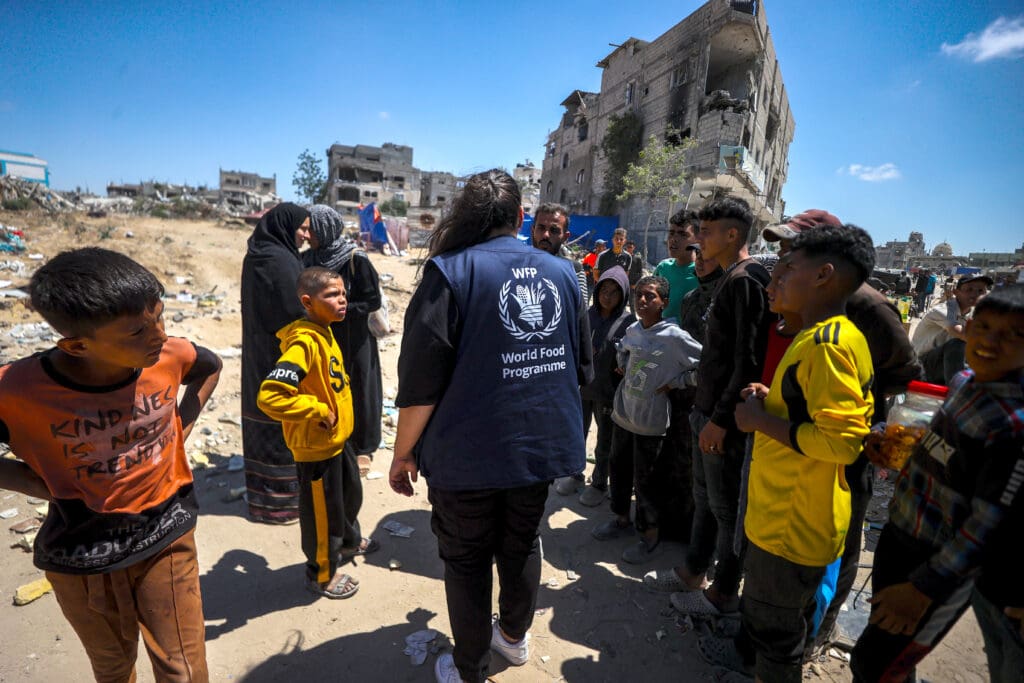
October 9, 2024 marks one year since WFP launched emergency operations in Gaza.
An unprecedented humanitarian catastrophe has unfolded in Gaza over the past year. People are suffering from conflict, displacement and starvation. The delivery of humanitarian aid has remained a challenge due to the ongoing violence and closed border crossings. Despite these obstacles, the United Nations World Food Programme (WFP) has continued to provide food assistance to Gazans, reaching 1 million people every month. We continue to call for a ceasefire and safe passage for humanitarian aid.
The U.N. World Food Programme has worked in Gaza since 1991 and significantly scaled up its emergency relief efforts over the last 12 months. Today, 90% of the population is displaced. Over 2 million people are facing crisis levels of hunger or worse. Emergency food assistance from the U.N. World Food Programme has helped avert famine, but the threat persists across the Gaza Strip.
Here’s a look at how this crisis unfolded over the past year and how the U.N. World Food Programme has responded.
Escalation of Conflict
The escalation of conflict in October 2023 caused the destruction of infrastructure and entire neighborhoods in Gaza. U.N. partners reported damage to several healthcare facilities and United Nations Relief and Works Agency (UNRWA) schools that now serve as shelters for displaced families. Many shops where people could redeem WFP vouchers to buy food were destroyed.
In the immediate aftermath of the first air raids, the U.N. World Food Programme began distributing fresh bread, canned food and ready-to-eat food to around 100,000 people who sought refuge in UNRWA shelters.
Humanitarian Aid Enters Gaza
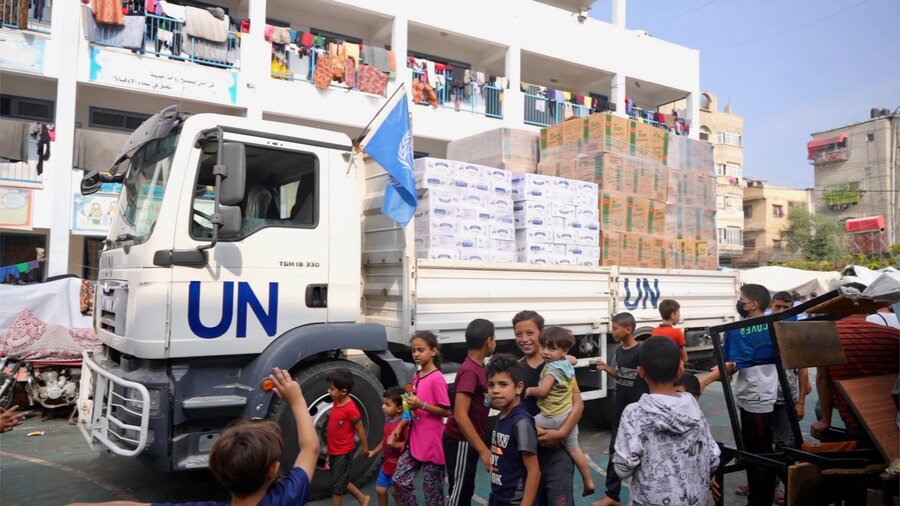
In the first week of our emergency response, the borders into Gaza were closed, preventing humanitarian aid from entering. However, the U.N. World Food Programme was able to distribute a limited amount of food from its warehouses inside Gaza.
October 21, 2023: The opening of the border crossing between Egypt and Gaza enabled the first convoy of trucks to bring in urgently needed food, water and other supplies provided by the Egyptian Red Crescent and the United Nations for hundreds of thousands of people who had been struggling amid desperate conditions. The convoy, which moved through the Rafah crossing, brought with it three trucks carrying over 130,000 pounds of emergency food.
Conflict & Hunger Cause Desperation
The ongoing conflict and chaos in Gaza took a severe toll on civilians and aid workers.
October 30, 2023: Thousands of people stormed a U.N.-run warehouse in central Gaza where the U. N. World Food Programme was storing food commodities.
“This is a sign of people losing hope and becoming more desperate by the minute. They are hungry, isolated, and have been suffering violence and immense distress for three weeks,” said U.N. World Food Programme Representative and Country Director Samer Abdeljaber.
The morning’s events followed a harrowing 24-hour communication blackout and persistent access challenges that brought all U.N. World Food Programme operations to a halt, leaving staff and partners disconnected.
November 2, 2023: After three weeks of conflict, a U.N. World Food Programme worker in Gaza recounted her experience:
“These past 18 days feel more like 18 years. They have shattered our dreams and forced our aspirations to shrink to simply scouring for drinking water and food…The war is eating away everything we know: people, buildings, hopes for a better future. The non-stop sound of bombs falling over the city – skipping our heads by luck – drills in my brain, draining me of sleep and the last drop of sanity I am holding on to.”
Breakthroughs in Food Relief
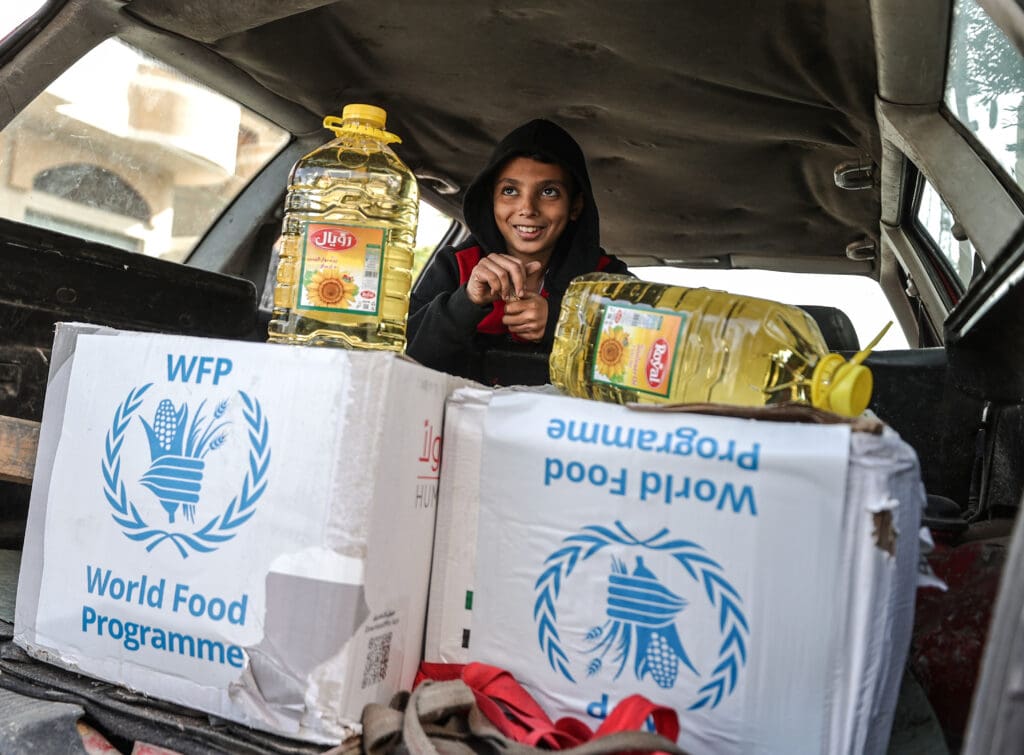
Throughout the conflict, significant challenges, including closed borders and unsafe conditions, prevented enough humanitarian aid from reaching people in Gaza. The U.N. World Food Programme continued to appeal for a ceasefire and safe, unimpeded passage to deliver food. Whenever crossings opened or there were pauses in fighting, our trucks delivered much needed food into Gaza.
November 26, 2023: During a six-day pause in fighting, the U.N. World Food Programme delivered desperately needed food to more than 120,000 people in Gaza. This aid included over 16,500 pounds of food delivered by an interagency convoy to around 23,616 people in Al-Ahli hospital and surrounding hard-to-reach areas.
December 20, 2023: A 46-truck convoy, organized by the U.N. World Food Programme and the Jordan Hashemite Charity Organization (JHCO), carried more than 1.65 million pounds of lifesaving food into Gaza, marking the first time a direct aid convoy from Jordan had reached the Gaza Strip since the surge in hostilities began in October. After 10 weeks of the crisis in Gaza, half of the population faced starvation, with little access to food, water and shelter.
Conflict and Hunger in Gaza Increase
By December, the war had fueled catastrophic levels of hunger in Gaza and the risk of famine loomed.
December 21, 2023: An Integrated Food Security and Nutrition Phase Classification (IPC) report confirmed the entire population of Gaza – roughly 2.2 million people – faced crisis levels of hunger or worse. Of those 2.2 million people, 576,600 faced catastrophic hunger and starvation. The report warned of the risk of famine, unless access to adequate food, clean water, health and sanitation services was restored.
January 15, 2024: Since the 6-day humanitarian pause in November, food had not been able to reach northern Gaza. For the first time since that pause, the U.N. World Food Programme’s food convoy entered northern Gaza and delivered food supplies for around 8,000 people.
Challenges and Barriers to Humanitarian Aid
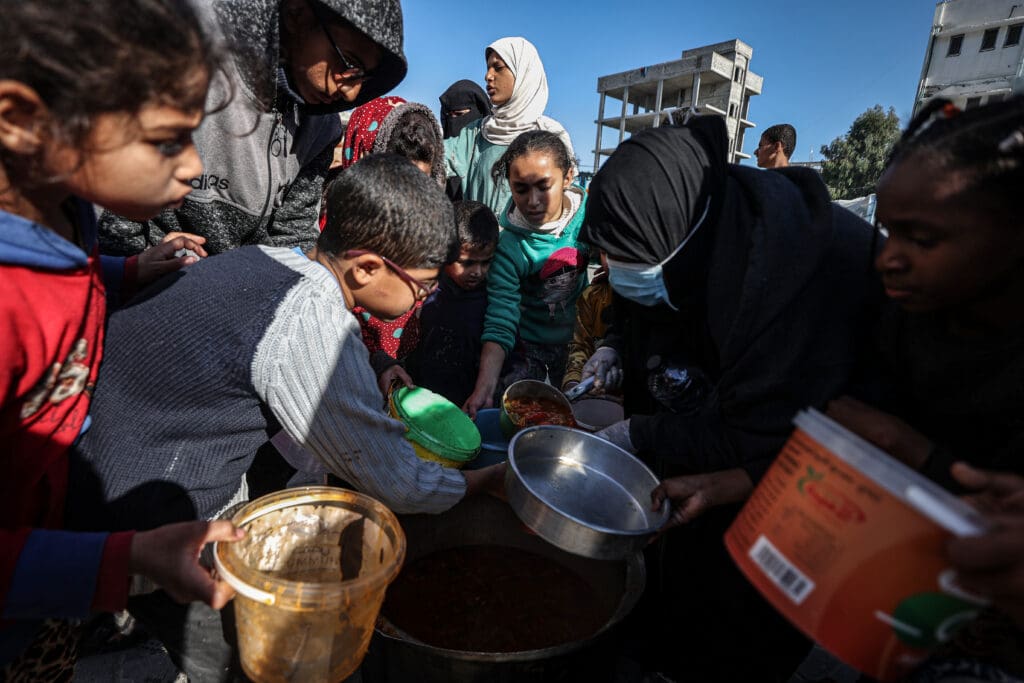
In order for food aid to reach people in Gaza, there needs to be a consistent flow of trucks across the border and safe passage to their destinations. However, closed border crossings had prevented dozens of trucks – full of aid – from entering for weeks. When they were able to get through, convoys faced many challenges to deliver aid including a lack of security.
January 25, 2024: In late January, there were only two open border crossings into Gaza, both on the Egyptian side. Lengthy checks on the Gaza side created bottlenecks that stopped WFP in its tracks. Drivers stood outside in the narrow lanes formed between the lines of trucks, prepared to go at any moment. Some prayed on mats on the ground, some chatted, their voices quiet with tiredness. Many slept in their cabs for multiple nights waiting at the border.
In late January, 120 trucks, including 73 U.N. World Food Programme trucks, passed through the Rafah border crossing. This is significant: Two weeks prior, only 60 to 80 vehicles were getting through. The increase was the result of a new inspection point just two miles from the Rafah border. Everything that crossed through underwent extensive inspection.
By the end of January, despite challenges, WFP had delivered the highest amount of food to Gaza since the start of the crisis: 48M pounds of food for 1.4 million people.
February 18, 2024: The plan was to send 10 trucks of food for seven straight days. However, on Sunday, as the U.N. World Food Programme started the route towards Gaza City, the convoy was surrounded by crowds of hungry people desperate for food. First fending off multiple attempts by people trying to climb aboard our trucks, then facing gunfire once we entered Gaza City, our team was able to distribute a small quantity of the food along the way. The next day, the second convoy’s journey north faced chaos and violence due to the collapse of civil order. On February 20, the U.N. World Food Programme paused food deliveries to northern Gaza until safe passage could be secured. With Gaza hanging by a thread and few options for survival, situations like these are increasingly common.
Finding Ways to Get Food into Gaza
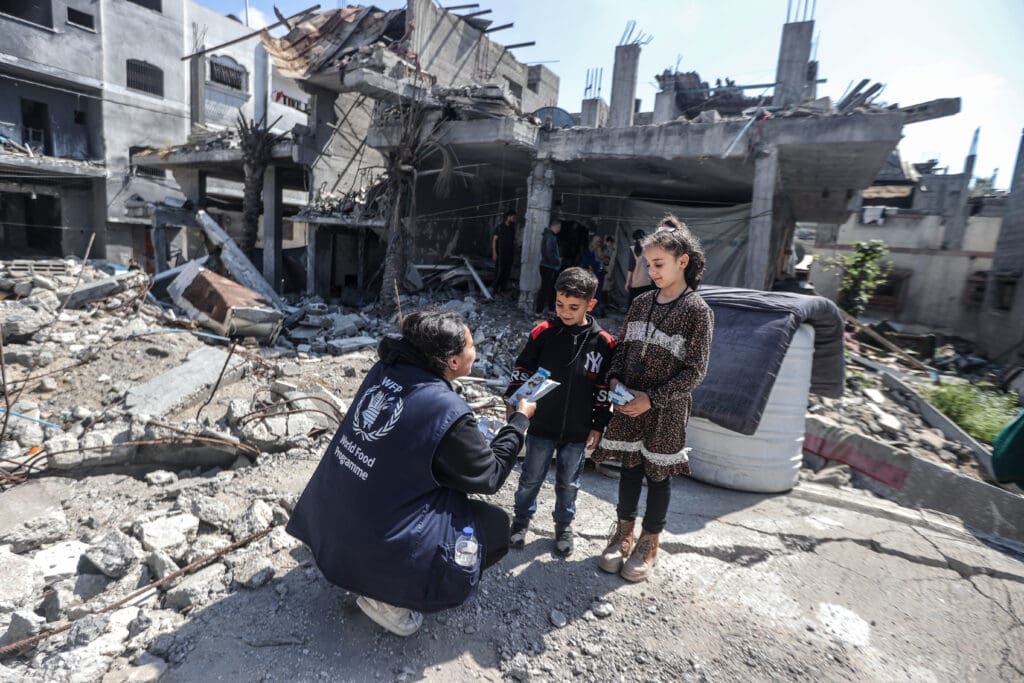
Whenever the U.N. World Food Programme faces challenges in delivering aid, it tries to find other ways to reach people in need – including new routes or alternative delivery methods.
March 5, 2024: A 14-truck food convoy – the first by the U.N. World Food Programme since it was forced to pause deliveries to the north on February 20 – was turned back by the Israeli Defense Force after a three-hour wait at the Wadi Gaza checkpoint. After being turned away, the trucks were rerouted and later stopped by a large crowd of people who desperately took around 450,000 pounds of food from the trucks. With so few food deliveries due to limited access, people will do whatever it takes to feed their families.
After these setbacks in delivering aid to northern Gaza, the U.N. World Food Programme turned to air drops, despite its inefficiency and danger involved. With the help of the Royal Jordanian Air Force, WFP air dropped enough food into northern Gaza for nearly 20K people. However, air drops are dangerous and don’t supply the amount of food people need. Knowing that trucks are the most effective and reliable method for food delivery, WFP strengthened its call for safe land access.
“Airdrops are a last resort and will not avert famine. We need entry points to northern Gaza that will allow us to deliver enough food for half a million people in desperate need,” said Carl Skau, the U.N. World Food Programme’s deputy executive director.
March 18, 2024: The U.N. World Food Programme delivered 18 truckloads of food supplies to Gaza City. The convoy, the second to use a coordinated route into Gaza City and the north, delivered 600,000 pounds of wheat flour, food baskets and ready-to-eat rations. Dispatching aid to the north of Gaza required day-to-day approvals from Israeli authorities. During the long waits at the Wadi Gaza checkpoint, truck convoys faced lootings and were frequently turned back. If they did get through, there was a high risk of more looting along the difficult route north. Incidents of looting reflect the amount of desperation from people on the edge of starvation.
Tragedy and Setbacks for Humanitarian Efforts
Conflict settings are dangerous environments for humanitarian workers. For our staff and for aid to be delivered effectively, there must be guaranteed safe passage. However, the continued escalation of conflict in Gaza has made humanitarian work increasingly dangerous.
April 1, 2024: Seven World Central Kitchen humanitarian workers were killed by an airstrike. Their deaths brought the total number of humanitarian workers killed in Gaza to nearly 200 in just six months, far higher than any other modern conflict.
May 6, 2024: Both the Kerem Shalom and Rafah crossings, the only two entrances into Gaza from the south, were closed. This, in combination with escalation of military activity in Rafah, put civilians at higher risk of hunger.
Ceasefire and Safe Passages Are Needed
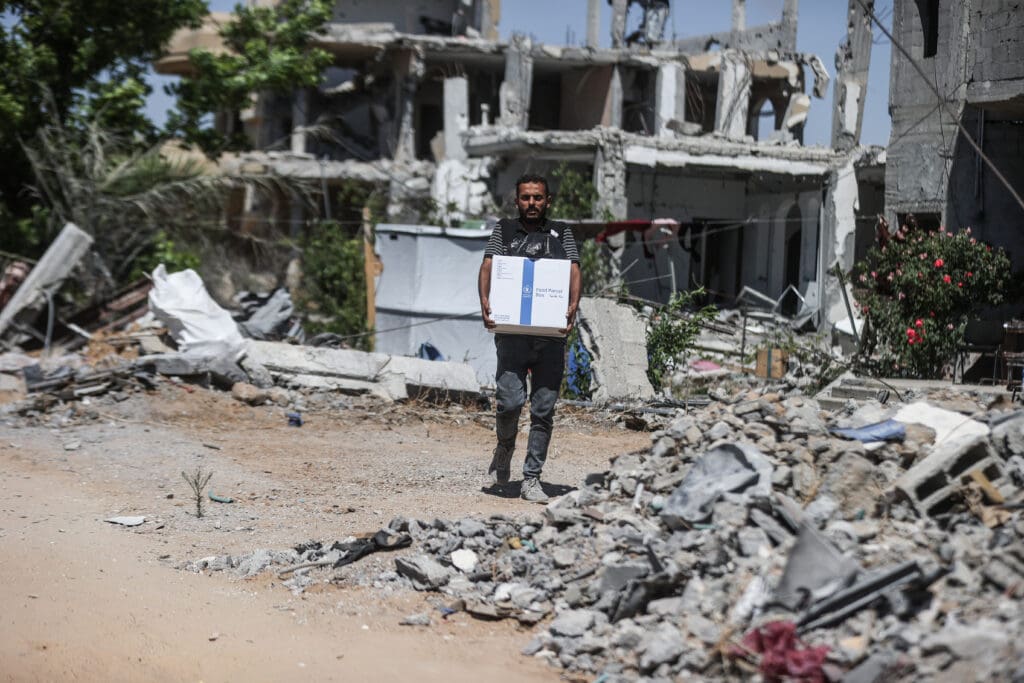
May 15, 2024: After months without access, a new coordinated route to the north, plus use of the Erez crossing and the Ashdod port, allowed the U.N World Food Programme to double the amount of aid that was delivered in April to northern Gaza.
June 16, 2024: As fighting escalated in southern and central Gaza, the toll on civilians was devastating. The hostile operating environment made it nearly impossible for humanitarian operations to deliver desperately needed food.
“It is getting harder to do our job. Staff spend five to eight hours waiting at checkpoints every day. Missiles hit our premises, despite being deconflicted. The breakdown of law and order means we also face looting and violence amid a large security vacuum,” said Carl Skau.
In northern Gaza, there were improvements in assistance where the U.N. World Food Programme and partners could deliver supplies through West Erez crossing.
Today, conditions in Gaza are extremely volatile and nowhere is safe. Despite immense access and security challenges, we are distributing food across the Gaza Strip and reached 1 million people in June. However, a high risk of famine persists in Gaza as long as the conflict continues and humanitarian access is restricted.
The U.N. World Food Programme continues to call for an immediate ceasefire so we can deliver urgently needed food assistance. We also appeal for the safe and unobstructed passage for our staff – humanitarians must be protected.
August 27, 2024: A WFP team was returning from a mission when it came under fire near an Israeli check point. Despite the trucks being clearly marked and receiving multiple clearances by Israeli authorities to approach, the vehicle was directly struck by gunfire as it moved towards an Israeli Defense Forces (IDF) checkpoint.
October 9, 2024: This day marks one full year since WFP launched its emergency response in Gaza and the West Bank. The situation remains dire, but WFP has managed to overcome enormous obstacles in delivering aid. We are one of the few humanitarian agencies still operational in Gaza, and we deliver food to more than 1 million people each month. To date, we’ve repaired 14 miles of the most critical roadways and driven 9K trucks into Gaza carrying over 300M pounds of food.
However, the risk of famine remains extremely high, which is why we continue to call for an immediate ceasefire and for the safe passage of our staff. Civilians and humanitarians must be protected.




